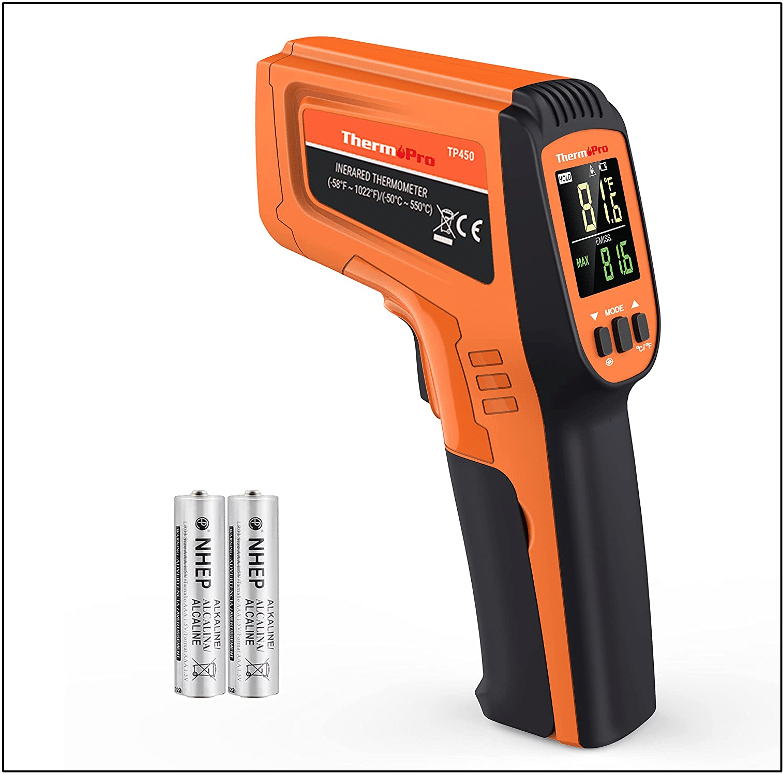Infrared thermometers are now commonly used in various fields, including the kitchen, as well as in industry. By providing an instant and accurate temperature reading, they make difficult operations simple and help us avoid very hot or very cold conditions. Learning these devices is well worth the effort for any cook who wishes to master their use or for a do-it-yourselfer who wants to fine-tune their accuracy.
In this article, you will learn all about infrared thermometers and their features, as well as their applications and tips on how to use them. Let’s jump in!
What is an Infrared Thermometer?
An IR thermometer simply takes the temperature of a surface by measuring the infrared radiation given off by the object. Rather than touching the surface, it takes the heat and translates it into temperature readings, as in the case of thermal imagers. This non-contact technology makes it efficient for use in situations where normal thermometers cannot be used effectively.
Key Components:
- Lens: Focuses the infrared energy.
- Detector: Captures and converts energy into electrical signals.
- Display: Shows the temperature in real-time.
How Infrared Thermometers Work
Every object emits infrared radiation, which increases with its temperature. When you point an infrared thermometer at an object, it collects this radiation and translates it into a temperature reading. This non-invasive method is both quick and practical.
Benefits of Using Infrared Thermometers
Let’s explore some benefits of utilizing Infrared thermometers in your cooking.
- Fast and Accurate: Infrared thermometers offer almost instant readings, which is ideal for professionals needing quick temperature checks.
- Non-contact Measurement: Noncontact measurements are invaluable in environments where hygiene is crucial, such as cooking or medical settings. The same applies to hazardous industries where measuring hot surfaces directly could pose safety risks.
- Versatile Applications: IR thermometers are useful in various settings, from grilling steak to monitoring machine parts.
Practical Applications
Now that you are familiar with the benefits of using infrared thermometers let’s talk about their practical use of them.
Cooking

Infrared thermometers have found a permanent place in professional kitchens. They ensure everything, from seared meat to oven-baked pizza, is perfectly cooked. For instance, the ThermoPro TP450 Dual Laser Infrared Thermometer for Cooking is a popular choice for chefs and food enthusiasts alike. Dual-laser technology accurately targets food surfaces, ensuring you achieve the ideal temperature for every dish.
Home Maintenance
In HVAC systems, these thermometers are used to detect air leaks, ensuring efficient energy use. They can also check wall insulation, refrigerator performance, and electrical panel temperatures to prevent breakdowns.
Industrial and Scientific Uses
Infrared thermometers are indispensable in laboratories and industries. They monitor equipment temperature, ensuring machinery doesn’t overheat. In electrical applications, they help technicians detect hot spots in circuits and prevent system failures.
How to Use an Infrared Thermometer Correctly
Using an infrared thermometer is easy, but there are some tips to ensure accurate readings:
- Aim carefully: Point the thermometer at the exact spot you want to measure.
- Maintain the right distance: Check the distance-to-spot ratio in your device’s manual for effectively measuring temperature.
- Avoid shiny surfaces: Shiny metals reflect infrared radiation, which can lead to inaccurate readings. Place masking tape or a non-reflective material over such surfaces before measuring.
Calibration: Ensuring Accuracy Over Time
Calibration ensures your thermometer stays reliable by adjusting its readings to a known standard. This is particularly important in professional and industrial settings, where precision is non-negotiable.
If you’re wondering how to calibrate infrared thermometer devices accurately, here’s a quick rundown: the process usually involves comparing your thermometer’s readings against a known, controlled heat source. Common methods include using an ice bath or a blackbody calibrator to ensure precision. Calibrating infrared thermometers regularly can improve their accuracy, so you get reliable temperature readings every time.
Choosing the Right Infrared Thermometer
Selecting the ideal infrared thermometer for your needs can significantly affect measurement accuracy and ease of use. Here are some key factors to consider:
1. Accuracy
Infrared thermometers are used when accuracy and sensitivity are important; that is, they have low measurement error and come with calibration settings to ensure that the device is consistently accurate throughout its life, especially with heavy usage or in varying conditions.
2. Temperature Range
Infrared thermometers are available in different models, and they are characterized by varying applicable temperature ranges. If you’re operating in factories or using the thermometer in areas with higher temperatures like AC and welding, manufacturers produce thermometers that can read temperatures above 500°C.
A standard range is adequate for normal or cooking purposes and can go up to 300°C in most cases. Chasing the right range enables your device to work out the best temperatures you can safely and effectively cope with.
3. Distance-to-Spot Ratio (D-Ratio)
The D-ratio tells you how close you can get to an object while still getting an accurate reading. Higher ratios (such as 12:1 or 20:1) mean you can measure small objects from a far distance. Higher D-ratios are definitely worth it if you need to check tight places or things from a safe distance.
4. Additional Features
The dual lasers help you target accurately, the backlit display lets you read low-light results, and the option to switch between Celsius and Fahrenheit keeps things flexible. Though these features aren’t essential, they can add convenience, especially when you use your thermometer frequently or in different settings.
Troubleshooting Common Issues
If your infrared thermometer gives inconsistent readings, here are some quick fixes:
- Check for debris: Clean the lens, as dust or smudges can distort readings.
- Incorrect distance: Ensure you are following the recommended D
Ratio. - Ambient conditions: Avoid extreme humidity or temperature fluctuations when taking measurements.
Final Thoughts
Infrared thermometers are potent tools that simplify temperature measurement across various applications. Whether you’re cooking a perfect steak or ensuring your air conditioner runs efficiently, these devices are designed to make your life easier. You can measure temperatures accurately and effortlessly with options like the ThermoPro Infrared Thermometer.
